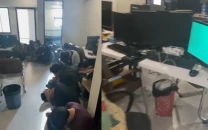Long goodbye of the printed word
.

On every World News Day (September 28), amid the loud calls to celebrate journalism, the death knell tolls even louder for the print format of newspaper. The demise is being precipitated by the ever-morphing Proteus of technology. We are the witness of media transformation. It's not just a change of format; it's a cultural metamorphosis with far-reaching implications.
It's not just an issue of content and container. It's a matter of mental and physical health of the consumer. The printed newspaper, once a cornerstone of public life and democratic discourse, is actually going to be the last civic campfire.
It's quite disheartening to see the newspapers thinning as if starved on an involuntary diet. The pullouts have been shelved. The opinion pages have shrunk to half. Some newspapers have abolished their editorials. The abolition marks a deleterious trend that authenticity and institutional ideological stand on major issues are needed no more.
Circulation of newspapers in paper has plummeted to an all-time low, as electronic and social media rule the roost because of their ubiquitous presence in the readers' social biome through small to large rectangle screen. Also, news on screen requires little effort and less mastery of language from the viewers.
Most Urdu newspapers now consist of eight to ten pages – an emaciated heft compared with the plump outsize of their heydays. Expenditures have exceeded profits as newspapers were orphaned of state and private advertisements. Second, marketing moved to the internet to find instant and wide reach. Classifieds – jobs, property and matrimonials – have eloped with the internet.
However, English newspapers in Pakistan deserve appreciation, as their number of pages (18-odd) is greater than that of their Urdu counterparts (8-odd) under the same price tag of Rs35. Even the quality and size of the pages of English newspapers are far better.
If capitalistic gains are held as the yardstick to measure the survival of newspapers in print, their days are numbered, as some newspapers and magazines have already shut down their publication or switched over to e-editions. In 1992, before www became part of the lingua franca, Warren Buffett, the Oracle of Omaha, predicted the decline of print media: "Simply put, if cable and satellite broadcasting, as well as the internet, had come along first, newspapers as we know them probably would never have existed." Remember, he is an avid reader of newspapers at the rate of five a day.
Buffett reasons out the financial downfall of media franchises: "An economic franchise arises from a product or service that is: (1) is needed or desired; (2) is thought by its customers to have no close substitute; and (3) is not subject to price regulation." The inevitability of newspapers was cancelled out by the availability of easy choices around the readers, who metamorphosed into listeners and viewers out of convenience.
The print media itself took a dogged stand for not tweaking itself to cater to the ease and appeal of the readers. It didn't stop using journalese, which required from the readers a mastery of language. This is more true in the case of the text-heavy format of Urdu newspapers. Also, it didn't evolve to be interactive with the readers.
The more the deep state intrudes into the country's functioning, the more steeply public trust in the news dwindles. Because it works covertly, contrary to what is overt to the public. The validity of news falters. The second blow is the loss of the sting of news on print media vis-a-vis the efficacy of the virality of visuals on social media, as individual and community voices desire to be heard asap. The reliance on state patronage in the form of advertisements made newspapers vulnerable to political pressure.
However, if the depth and health of cognition are held supreme, human civilisation anxiously awaits the print renaissance. The demographic segment most hit by the shift will be the one pursuing learning and teaching skills. The shift of format is generational and isn't irreversible. Coexistence or a Maxican standoff.
Note: This article should be read in continuation of my earlier piece "May the print live long!" printed in these pages.















COMMENTS
Comments are moderated and generally will be posted if they are on-topic and not abusive.
For more information, please see our Comments FAQ